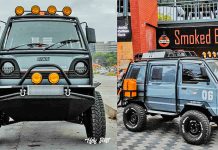19 Things Most People Don’t Know About Police Cars
According to Autowise, the very first motorized police car dates all the way back to 1899 in Akron, Ohio. While it was motorized, it was done so by the help of two electric-powered engines that could reach a top speed of just 16 mph and only had a 30-mile range before it had to be recharged. The wagon was even fashioned with lights and a siren. While the wagon was equipped with a siren, it was actually a gong that had to be banged on. The wagon was destroyed during the “Riot of 1900” after people banded together and pushed the vehicle into the water.
While most police departments have since upgraded their technology and switched to traditional police-issued vehicles, some squads are patrolling in more desirable vehicles, and we’ll mention some of them on this list. Here are 20 facts about police cars that may surprise you.
19 UNMARKED
 We all notice them on the roads and can’t help but slow down when one’s in our presence. An unmarked police car will make even a law-abiding citizen nervous. But what’s the deal with them? In a story covered by ABC, a Washington man recorded himself as he demanded a police officer in an unmarked vehicle for his ID. The man was able to prove the officer wrong by educating him on a law that prohibits unmarked cars from making routine stops in that jurisdiction, with the only loophole being the use of the vehicle for “special undercover or confidential investigation purposes.”
We all notice them on the roads and can’t help but slow down when one’s in our presence. An unmarked police car will make even a law-abiding citizen nervous. But what’s the deal with them? In a story covered by ABC, a Washington man recorded himself as he demanded a police officer in an unmarked vehicle for his ID. The man was able to prove the officer wrong by educating him on a law that prohibits unmarked cars from making routine stops in that jurisdiction, with the only loophole being the use of the vehicle for “special undercover or confidential investigation purposes.”
18 SMART CARS

According to Forbes, most police cars are now equipped with a technology called DDACTS, which is short for “Data-Driven Approach to Crime and Traffic Safety.” But what does all of that mean?
In plain terms, it means that as a cop car is patrolling, the surveillance system is constantly taking high-resolution pictures that work in conjunction with the police database.
These photos are then cross-referenced by a database of wanted vehicles, which then helps catch criminals at large.
17 UN-STEALABLE

Have you ever wondered why cops leave their vehicle running when they’re not in it? Is it that they’re tempting people to steal it? Cops simply leave their car running to keep the radios, lights, and surveillance system running without killing their battery. If you’re tempted to steal it, you’ll have a tough time, as they’re equipped with a run lock system that, while it allows the vehicle to run without the key in the ignition, cuts off the engine if the driver tries to shift out of park while the key isn’t in the ignition.
16 WAIL!

Extreme Tactical Dynamics, a company that sells police sirens, explains the difference between all the different tones that are used in a police car. For example, a wail, a piercer, and a howler or a rumbler are all common sirens that are used for everyday use. A wail is commonly used to alert people on the roads and streets, while a piercer is used in heavy traffic. A howler or a rumbler, as discussed earlier, is a combination of sirens and low-frequency tones.
15 COVER ME!

You’ve probably seen in the movies where the cop is having a standoff with a perp that the cop sometimes uses his or her car door as a shield. According to an article in The Star, Ford has been offering bulletproof doors for well over a decade now, but up until a few years ago, the doors were only rated to protect officers from handguns and certain bullets.
The new doors are rated to stop up to a .30-calibre bullet that would be used in a high-powered assault rifle.
Not all police cars are equipped with this feature just yet, but hopefully, they’ll all be in the near future!
14 RACECARS

Obviously, cop cars come with upgraded engines, but how fast are they? A report was done by USA Today to see what the fastest police car is on the market. The test proved that the Ford Taurus with a turbocharged 3.5-liter engine was the fastest patroller, putting down a 0-60 in 5.7 seconds. The Dodge Charger took first in stopping distance, and the Chevy Caprice took the cake for top speed at 155 mph. Nonetheless, the most popular police vehicle is still the Ford Explorer due to its versatility.
13 YOUR LIGHT BAR IS ON!

LED Outfitters, a company that sells lights to emergency personnel, explains why the traditional use of red and blue came to be.
Most people associate the color red with stopping, so it makes sense to use red, but it’s also used due to the fact that it has the longest wavelength.
Therefore, it’s the easiest to see. But why blue? Experts say that it’s simply used, as people that are color-blind and can’t see red can most likely see blue. How interesting.
12 BACKSEAT DRIVER

Most people are familiar with the fact that the backseats of police cars can’t be opened from the inside, for obvious reasons. Here are a few things that you may not know about the backseat of a police car. According to How Stuff Works, the backseat of a police cruiser doesn’t have cloth seats to ensure easy cleanup if any bodily functions are left behind. In addition, the barrier between the front and the rear seat is protected by metal plates to help prevent a person in custody from trying to hurt the officers in the front seat.
11 K9 CRUISER

K9 vehicles need to be equipped with special equipment to help ensure that the furry police officer is just as safe as its owner. The source even mentions that there have been numerous accidents where dogs have died from heat stroke due to being left in a vehicle that was too hot for them. In addition to proper cooling, the dogs must be kept safe in a cage that’s custom built into the vehicle. These upgrades can cost thousands of dollars to install to ensure that the K9s are properly cared for while on the job, like any part of the squad.
10 911 CONFIRMATION

While it’s legal in most states for an unmarked car to pull you over, you should know you do have rights as a civilian that can be used in order to keep yourself safe. According to Autowise, most states have laws that require a person to pull over for a vehicle that has flashing lights. You do have the right to call 911 to call and confirm that the unmarked vehicle is, in fact, a cop. Just make sure that you’re legally using your phone or a handsfree device if it’s against the law in your state. Otherwise, you’ll get a ticket for that as well.
9 BASIC MAINTENANCE

Police cars take a lot of abuse while being out of the streets, so it’s no surprise that they need to be maintained more than the average. According to Thrillist, police cars are equipped with meters that read the number of hours the car has been on rather than miles driven to give a more accurate reading of how much abuse the vehicle may have endured whether it was driving or idling.
8 DAILY DRIVER

Your daily driver is a police cruiser? According to the Honolulu Advertiser, the officers that chose to use their personal vehicles as police cars will be responsible for covering the cost of insurance and maintenance and are compensated with a stipend to cover the cost. The police department is responsible for getting the patrollers properly equipped with the right equipment needed for the job, like radios, sirens, and lights. Police departments do this in an effort to help cut cost while speeding up response times to calls. They also hope that the cars will be taken better care of if it’s the officers’ own.
7 SUPERCAR POLICE CAR

Imagine patrolling in a supercar? According to CNN, some lucky officers in Dubai get to do just that! By doing so they became the Guinness World Record holder for the world’s fastest police car. While the fastest of the bunch is the Bugatti Veyron, it’s not the only supercar in their fleet. The rest of the lineup includes a Bentley GT, an Aston Martin 0ne-77, a few Porsche Panameras, and a couple BMW i8’s. I’m sure the officers are constantly fighting over who gets to drive!
6 WHO’S #1?

While the Police Interceptor SUV may not be the fastest on the team, it’s the most versatile, and pretty soon, it’ll be getting the power that it deserves. According to Car and Driver, there will be a new and improved SUV in town as of 2020. According to the sneak peak, the Explorer will be coming with 3.5-liter EcoBoost that we already find in the Police Interceptor and is currently the fastest cruiser available. Ford is estimating that the Explorer will receive a ballpark mpg combined rating of 24 mpg.
5 ATTENTION TO DETAIL

Cop cars often come with little differences that may not seem to be very important to the average person but can make a world of a difference to a person in uniform. For example, according to Car and Driver, the Police Interceptors are equipped with a column shifter instead of a console shifter. This not only frees up space on the console for other equipment but also makes for an easier and quicker exit. In addition, a police car’s seats are modified to accommodate an officer’s utility belt. Furthermore, the back doors open at a different angle to make it easier to load people into the back of the car.
4 ELECTRIC POLICE CAR

It’s funny to think that the fastest police car in the States is one that has an EcoBoost engine, but it does. At the end of the day, it’s actually very cost effective, considering a patrol car is running more times than it isn’t. According to Fastest Laps, the Ford Interceptor comes stocked with a 3.5-liter V6 that comes turbocharged with a set of twins. The Interceptor’s EcoBoost can produce 365 hp at 5,500 rpm and 350 lb/ft of torque at 3,500 rpm and needs just 5.7 seconds to go from 0-60!
3 BORDER CONTROL

The Mexican US border consists of rough desert terrain. According to Autowise, in the past, Border Control didn’t have any other choice but to modify trucks and SUVs to be able to handle the abuse they take while patrolling in the extreme off-road conditions. However, when Ford released the Raptor, it was like a match made in heaven. But there was a bit of a holdup on getting the officers their rigs due to issues with the leather interior. Ford eventually sorted out the issue and got the government officials Raptors with a cloth interior rather than a leather one.
2 UPGRADES ALL AROUND

We’ve already discussed the fact that police rigs come with upgraded powertrains for obvious reasons, but they also get other mentionable upgrades as well. According to Autowise, a police car’s alternator must be upgraded to support all the additional juice it needs to power their radios, their lights, and their surveillance equipment. All that extra equipment comes with an additional weight factor that the car must be able to handle while still being nimble enough to chase after speeding vehicles. Additional upgrades to police cars’ suspensions and braking systems must be performed to do so.
1 THE RUMBLER

The rumbler? Sounds like more of a pro wrestler’s name rather than a police device that’s used to help pull vehicles over. In the past, police cars used the good old-fashioned lights and sirens to pull over a vehicle, but recently, cars have been using a new technology that you can feel, literally. According to Autowise, the rumbler is a combination of both a siren and a low-frequency tone that you’ll literally feel in your vehicle. This is a relatively new technology but is quickly making its way into police cars everywhere.
Sources: Autowise.com, TheNewYorker.com



















